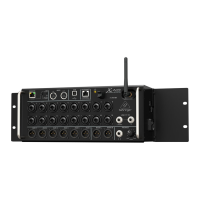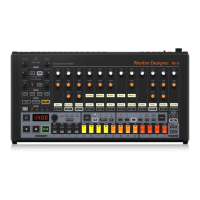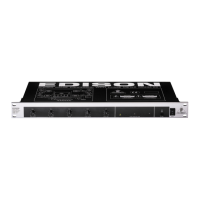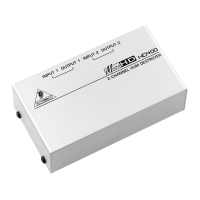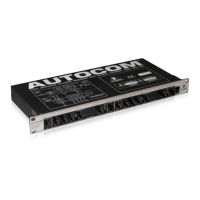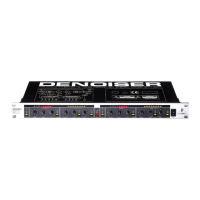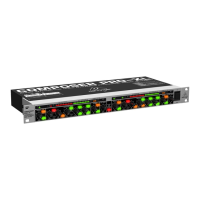9
BLUE DEVIL GX112
+ When the MIDI functions are inactive, one effect can be stored for each of the two channels on
your BLUE DEVIL, which allows you, for instance, to select a DELAY effect for the HELL
channel and assign a REVERB/CHORUS effect to the HEAVEN channel. The corresponding
program numbers will be stored with the channels and can be recalled using the footswitch or
the front panel buttons. When MIDI is on, this assignment feature will be disabled, so that in
this mode both channels and effects can be selected separately.
13
The STATUS LEDs inform you about the type of parameter you can edit with the PARAMETER control
(an exception being the MIDI LED).
s MIDI: This LED lights up when you press both UP and DOWN buttons for about 2 seconds. Subsequently,
you can use these keys to set up a MIDI channel for MIDI data reception (1 through 16, ON for Omni
mode and OF for off, or ON for Omni mode and 1 through 16 plus one decimal point each for the
store enable mode, see chapter 3.2.1). Press the ENTER button to confirm your selection. The MIDI
LED flashes as soon as MIDI data are being received.
+ The store enable mode (see chapter 3.2.1) allows you to store presets directly via MIDI. Please
note that by sending MIDI controller #18 values, any changes made to the currently active
preset will be irrevocably stored.
+ If the multi-functional MIDI LED flashes briefly, this indicates that the DSP modules output level
is close to distortion. In this case, you should turn down the VOLUME control a bit. This
clipping indicator is only available if you actually do not edit any parameter.
s TIME: This LED lights up when you select a time-domain effect parameter (e.g. reverb or delay time).
s SPEED: This LED lights up for all modulation effects and indicates the LFO speed (low-frequency
oscillator) or the compressors or expanders speed parameter.
s SENS: This LED informs you that you can adjust the sensitivity of effects such as Auto Wah, Expander,
Compressor.
s PITCH: This LED lights up when you edit the pitch shifter and shows the detune factor, either in semi-
tones or cents.
s EQ: This LED lights up when you edit the parameters of a filter-based effect.
To the right of the status LEDs you can find a table that lists the various effect types as well as their initial
program numbers. Use this list to quickly locate, edit and store the effect of your choice. The built-in effects
module features 31 different effect groups and includes a total of 99 effect variations.
14
Use the EFFECT button to activate/deactivate the selected effect.
15
The PARAMETER control allows you to edit an effect-specific parameter. Once selected with the
PARAMETER control, its value is displayed and the corresponding LED lights up (see ).
16
The EFFECT A control determines the mix between original and effect signals. Depending on the
preset selected, you can either control the ratio of original and left-channel effect signal, or of original
and first-effect signal (combination effects). Some effects use this control to edit a second, effect-
specific parameter.
17
The EFFECT B control determines the mix between original and effect signals. Depending on the
preset selected, you can either control the ratio of original and right-channel effect signal, or of
original and secondary-effect signal (combination effects). Some effects use this control to edit a
third, effect-specific parameter.
+ When you start editing a preset, the decimal point in the 2-digit display starts flashing. Press
the ENTER button for a while to overwrite the factory preset and save your own effect setting.
To restore the factory presets, simply press and keep the ENTER button while you switch on
the BLUE DEVIL.
18
The AUX control in the Master section determines the volume of the AUX signal fed in via the AUX IN
jacks on the rear of the BLUE DEVIL (e.g. drum computer, playback).
19
The VOLUME control in the Master section determines the overall volume level of the BLUE DEVIL.
1. INTRODUCTION
